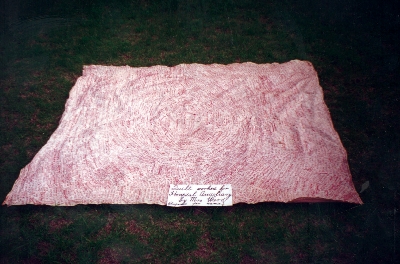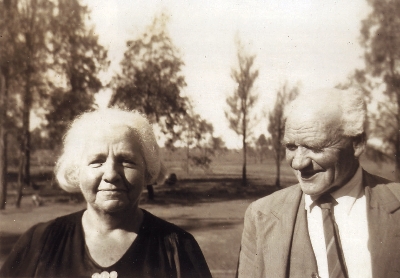Quilt No.1GM - Gilgandra Historical Society

2033 x 1474mm
The quilt was started by Mrs. Clara Ward in 1937 and finished in 1939. She embroidered all the signatures. It was made to raise money for the Hospital Auxiliary in Gilgandra. The quilt passed to Mrs. Ward's daughter, Clarice Scholtz and then to the Gilgandra Historical Society. It is sometimes displayed at the Gilgandra Museum.
The signatures on this fund raising quilt were all embroidered by Mrs. Clara Ward of "Wait-a-While" Biddon NSW. Clara Ward was born Clara Blackert at Nash's Flat near Mudgee in 1883. In 1913 she and her husband Percy moved to Biddon. They had 3 children: Allan, Frank and Clarice. Frank died at the age of 5 from diphtheria.
"The quilt was started in 1937 by 'Wardie' as she was affectionately known, the money raised at sixpence a name was solely to help raise funds to go towards the building of a new hospital. She embroidered the names whilst a patient at either 'Chinnock' Private hospital or the Gilgandra District Hospital or at her home in Biddon.
An article printed in the Gilgandra Weekly dated Thursday 8 June 1939 stated Mrs. Ward has completed the working of her quilt, at that stage there were 1,700 names, raising forty two pounds ten shillings. But as people still asked to have their names added to the quilt she recommenced work on the quilt and was still adding names up until the time of her death on the 31st. December 1950, she still charged sixpence but if anyone wanted their names found she charged one shilling. T he task of finding these names was done by her grandaughter Pat Lummis (nee Scholz) who was later to have the last baby born in the old hospital and with her new daughter Lyn were the first patients in the new hospital which was officially opened on the 10th February 1956, Lyn being born on the 12th February. Mother and daughter being transferred by ambulance to the new hospital on the 14th."
[Joyce Wise, Gilgandra Museum]


Related Quilts:
1790 x 1160mm
2290 x 1950mm
1474 x 1093mm
2120 x 1680mm






